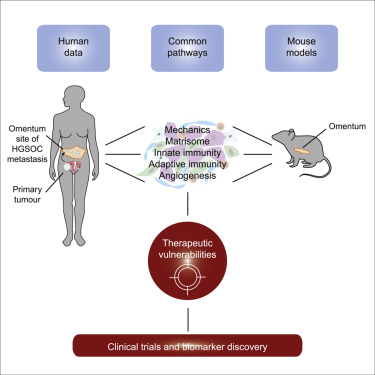Our official English website, www.x-mol.net, welcomes your
feedback! (Note: you will need to create a separate account there.)
Mouse Ovarian Cancer Models Recapitulate the Human Tumor Microenvironment and Patient Response to Treatment.
Cell Reports ( IF 7.5 ) Pub Date : 2020-01-14 , DOI: 10.1016/j.celrep.2019.12.034 Eleni Maniati 1 , Chiara Berlato 1 , Ganga Gopinathan 1 , Owen Heath 1 , Panoraia Kotantaki 1 , Anissa Lakhani 1 , Jacqueline McDermott 2 , Colin Pegrum 1 , Robin M Delaine-Smith 1 , Oliver M T Pearce 1 , Priyanka Hirani 1 , Joash D Joy 1 , Ludmila Szabova 3 , Ruth Perets 4 , Owen J Sansom 5 , Ronny Drapkin 6 , Peter Bailey 7 , Frances R Balkwill 1
Cell Reports ( IF 7.5 ) Pub Date : 2020-01-14 , DOI: 10.1016/j.celrep.2019.12.034 Eleni Maniati 1 , Chiara Berlato 1 , Ganga Gopinathan 1 , Owen Heath 1 , Panoraia Kotantaki 1 , Anissa Lakhani 1 , Jacqueline McDermott 2 , Colin Pegrum 1 , Robin M Delaine-Smith 1 , Oliver M T Pearce 1 , Priyanka Hirani 1 , Joash D Joy 1 , Ludmila Szabova 3 , Ruth Perets 4 , Owen J Sansom 5 , Ronny Drapkin 6 , Peter Bailey 7 , Frances R Balkwill 1
Affiliation

|
Although there are many prospective targets in the tumor microenvironment (TME) of high-grade serous ovarian cancer (HGSOC), pre-clinical testing is challenging, especially as there is limited information on the murine TME. Here, we characterize the TME of six orthotopic, transplantable syngeneic murine HGSOC lines established from genetic models and compare these to patient biopsies. We identify significant correlations between the transcriptome, host cell infiltrates, matrisome, vasculature, and tissue modulus of mouse and human TMEs, with several stromal and malignant targets in common. However, each model shows distinct differences and potential vulnerabilities that enabled us to test predictions about response to chemotherapy and an anti-IL-6 antibody. Using machine learning, the transcriptional profiles of the mouse tumors that differed in chemotherapy response are able to classify chemotherapy-sensitive and -refractory patient tumors. These models provide useful pre-clinical tools and may help identify subgroups of HGSOC patients who are most likely to respond to specific therapies.
中文翻译:

小鼠卵巢癌模型概括了人类肿瘤微环境和患者对治疗的反应。
尽管高级别浆液性卵巢癌 (HGSOC) 的肿瘤微环境 (TME) 中有许多前瞻性靶标,但临床前测试具有挑战性,特别是因为有关小鼠 TME 的信息有限。在这里,我们描述了根据遗传模型建立的六种原位、可移植同基因小鼠 HGSOC 系的 TME,并将其与患者活检进行比较。我们确定了小鼠和人类 TME 的转录组、宿主细胞浸润、基质体、脉管系统和组织模量之间的显着相关性,其中有几个共同的基质和恶性靶点。然而,每个模型都显示出明显的差异和潜在的漏洞,使我们能够测试有关化疗和抗 IL-6 抗体反应的预测。使用机器学习,化疗反应不同的小鼠肿瘤的转录谱能够对化疗敏感和难治性患者肿瘤进行分类。这些模型提供了有用的临床前工具,可能有助于识别最有可能对特定疗法产生反应的 HGSOC 患者亚组。
更新日期:2020-01-15
中文翻译:

小鼠卵巢癌模型概括了人类肿瘤微环境和患者对治疗的反应。
尽管高级别浆液性卵巢癌 (HGSOC) 的肿瘤微环境 (TME) 中有许多前瞻性靶标,但临床前测试具有挑战性,特别是因为有关小鼠 TME 的信息有限。在这里,我们描述了根据遗传模型建立的六种原位、可移植同基因小鼠 HGSOC 系的 TME,并将其与患者活检进行比较。我们确定了小鼠和人类 TME 的转录组、宿主细胞浸润、基质体、脉管系统和组织模量之间的显着相关性,其中有几个共同的基质和恶性靶点。然而,每个模型都显示出明显的差异和潜在的漏洞,使我们能够测试有关化疗和抗 IL-6 抗体反应的预测。使用机器学习,化疗反应不同的小鼠肿瘤的转录谱能够对化疗敏感和难治性患者肿瘤进行分类。这些模型提供了有用的临床前工具,可能有助于识别最有可能对特定疗法产生反应的 HGSOC 患者亚组。











































 京公网安备 11010802027423号
京公网安备 11010802027423号